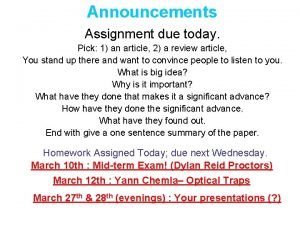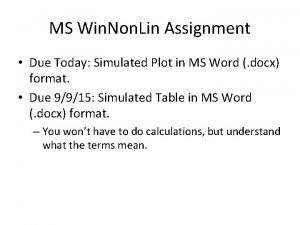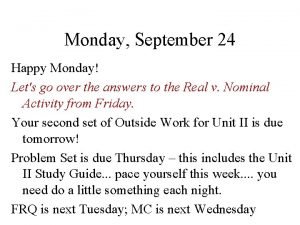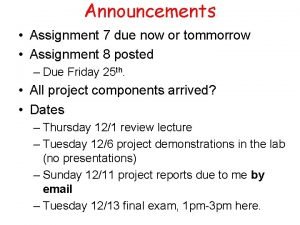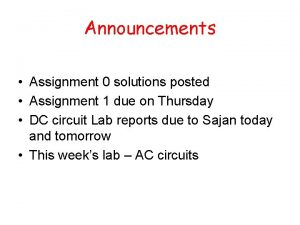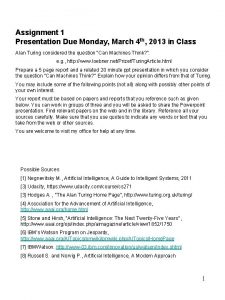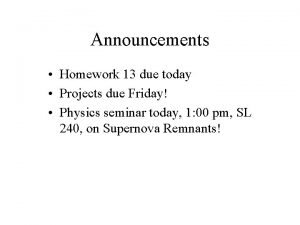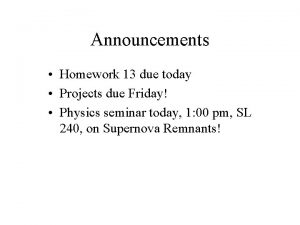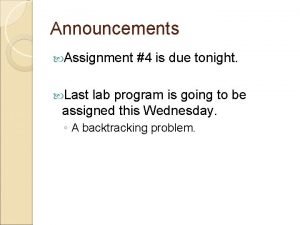Announcements Star Assignment 2 due Monday March 15



































- Slides: 35

Announcements • Star Assignment 2, due Monday March 15 – READ chapter 15, do Angel quiz • Global Warming Project, due Wednesday March 17 – Sample 4 web sites taking different positions on whether Global Warming is occurring & whether people are responsible. – For each site, evaluate the science - Is it good or poor? – Criteria (list from class discussion)

You already know a lot about the Sun • The Sun heats the Earth. What is the source of the Sun’s energy? • The color of the Sun is yellowish -> the Sun is hot. What makes the surface hot? • The Sun does not seem to change much. It is very stable. What keeps it stable?

Tour of the Sun

Basic Properties of the Sun Distance: 1. 5 x 108 km = 1 A. U. Mass: 2 x 1030 kg Radius: 7 x 105 km Density: 1. 4 g/cm 3 Luminosity: 3. 8 x 1026 watts

What does the Sun look like? Convection = Granulation Sunspots: Cooler -> darker

From the Surface up into the atmosphere (corona)

The Sun’s Magnetic Field


Magnetic Loops in the Corona

The Solar Corona in X-Rays

The Solar Wind


Stability: Pressure & Gravity • Gravity pulls in -- keeps Sun from dispersing into space, holds stars together • Pressure pushes out -- keeps Sun from collapsing

Gravitational equilibrium: The outward push of pressure balances the inward pull of gravity

Pressure is force exerted by colliding particles • Higher density --> particles closer together --> more collisions --> higher pressure • Higher temperature --> particles move faster --> more & harder collisions --> higher pressure

Equilibrium Pressure balances Gravity • Pressure = weight of overlying material • Pressure increases toward center to balance larger gravity toward center

Weight of upper layers compresses lower layers

What is the source of the Sun’s Energy? • How do we get energy here on Earth – Chemical reactions (burning) – Gravitation Potential Energy (hydroelectric) – Nuclear (fission reactors)

Chemical Energy: 108 J/kg Estimated life expectancy ~ 15, 000 years Earth is older

Gravitational Energy: 2 x 1011 J/kg Estimated life expectancy ~ 30, 000 years Earth is older

E= 2 mc - Einstein, 1905 Nuclear Energy: 5 x 1014 J/kg Estimated life expectancy ~ 1011 years ~ 100, 000, 000 years

What is the source of the Sun’s Energy? • Sun gets its energy by nuclear FUSION – Have not succeeded in containing nuclear fusion on Earth – Sun is a perfect nuclear fusion reactor • Contained • Safe • Slow

Fission Fusion Big nucleus splits into smaller pieces Small nuclei stick together to make a bigger one (Nuclear power plants) (Sun, stars)

Why does fusion occur ONLY in the Sun’s CORE ? • Nuclear fusion • a reaction where heavier nuclei are created by combining (fusing) lighter nuclei. • all nuclei are positively charged • Electromagnetic force causes nuclei to repel each other. • for fusion to occur, nuclei must be moving fast enough to overcome E-M repulsion • this requires high temperatures • When nuclei touch, the nuclear force binds them together

Electric Barrier

Hydrogen Fusion (pp chain)

Overall Reaction: 4 1 H --> 1 4 He + Energy

Why does the Sun Shine ? mass of He = 99. 3% of 4 x mass of H where did the. 007 (4 m. H) go? --> energy!!! E= 2 mc

The Solar Thermostat • Temperature increase --> increased fusion --> energy production greater than energy loss --> core heats up --> pressure increases --> pressure greater than gravity --> core expands --> cools (work against gravity) --> energy generation decreases

The Solar Luminosity • The Sun’s luminosity is stable over the short-term. • However, as more Hydrogen fuses into Helium: • • • four H nuclei convert into one He nucleus the number of particles in Sun’s core decreases with time the Sun’s core will contract, causing it to heat up the fusion rate will increase to balance higher gravity a new equilibrium is reached for stability at a higher energy output the Sun’s luminosity increases with time over the long-term • Models indicate the Sun’s luminosity has increased 30% since it formed 4. 6 billion years ago. • it has gone from 2. 9 x 1026 watts to today’s 3. 8 x 1026 watts

Energy Loss • Heat is produced in the core • Heat is lost (radiated away to space) from the surface • How is heat transported from the hot core to the (relatively) cool surface?

Inner 2/3 of Sun Heat is transported by RADIATION

Energy gradually leaks out of radiation zone in form of randomly bouncing photons

Outer 1/3 of Sun Energy is transported by CONVECTION

Convection zone: Hot gas rises and cool gas sinks
 Bearing gifts we traverse afar
Bearing gifts we traverse afar Poland national anthem lyrics
Poland national anthem lyrics What does montag hear in the seashell
What does montag hear in the seashell Pvu market cap
Pvu market cap Kluver bucy syndrome
Kluver bucy syndrome R/announcements
R/announcements General announcements
General announcements Church announcements
Church announcements Assignment due today
Assignment due today Assignment due today
Assignment due today Assignment due today
Assignment due today Venule
Venule Quadrilateri con 2 lati paralleli
Quadrilateri con 2 lati paralleli Due piccole sfere identiche sono sospese
Due piccole sfere identiche sono sospese Procedural vs substantive due process
Procedural vs substantive due process Nascita di sparta
Nascita di sparta Compare a* and ao* algorithm
Compare a* and ao* algorithm Star events stands for
Star events stands for Monday=621 tuesday=732 wednesday=933
Monday=621 tuesday=732 wednesday=933 Refers to the variety of training a performer undertakes
Refers to the variety of training a performer undertakes Sunday monday tuesday wednesday
Sunday monday tuesday wednesday Monday done right meaning
Monday done right meaning Come monday morning
Come monday morning December morning message
December morning message Happy monday quiz
Happy monday quiz Sit2play down
Sit2play down Response to happy monday
Response to happy monday Problem set #2 macro unit 2 macro measures
Problem set #2 macro unit 2 macro measures Monday evening prayer
Monday evening prayer Happy monday hope you had a great weekend
Happy monday hope you had a great weekend What is the difference between tone and mood
What is the difference between tone and mood Response to happy monday
Response to happy monday Monday
Monday On monday vlad felt unwell
On monday vlad felt unwell Hemmper
Hemmper Good afternoon monday
Good afternoon monday








